Documentary footage from the Bakersfield sound to the East Bay’s hyphy scene
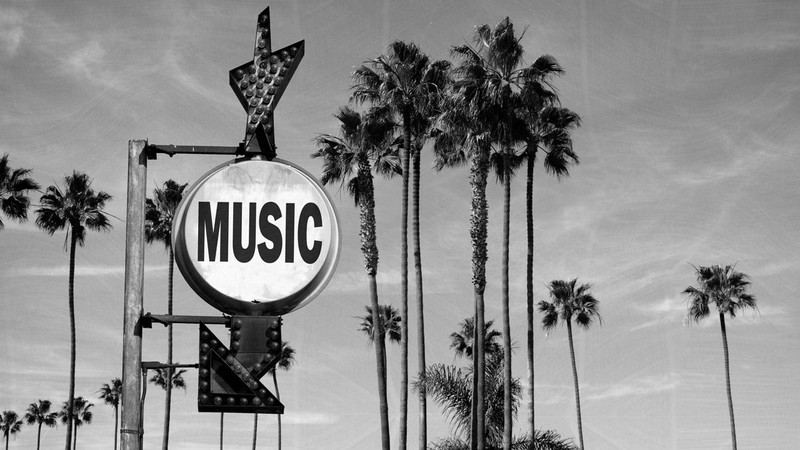
J.D.S Shutterstock
In 1850, fewer than 100,000 people called California home, and by the 2020 census, that number had grown to nearly 40 million. We know the downsides of explosive growth—traffic, urban sprawl, stratospheric housing prices. One big upside, however: a decades-long influx of musical creativity. Black jazz musicians brought life to Central Avenue in Los Angeles in the 1920s; displaced Okies planted the seeds of the Bakersfield sound—each new wave added to California’s culture. By the 1960s, even the music business had shifted on its axis, from New York’s Brill Building to the Sunset Strip.
Thanks to the century-old magic of motion pictures, bits and pieces of this musical history have been captured on film, and we’ve ferreted out some highlights. Because media coverage is never distributed equally (or equitably), this list is heavy on those scenes that attracted the most camera-wielding documentarians: L.A.’s Laurel Canyon and San Francisco’s Haight-Ashbury. But we also reached out to some music mavens to dig up some less-exposed film stock: Cary Baker, former owner of Conqueroo and head of publicity at Capitol and I.R.S. Records, who is now writing his first book; Mike Huguenor, a music journalist and musician who is penning a book on Asian Man Records; and Richard von Busack, a longtime film critic who’s spent years in the clubs and mosh pits of Los Angeles, San Francisco and the East Bay, and who has reviewed some of his favorites below.
We’ve got four types of docs listed below, in alphabetical order: documentaries about music scenes, spotlights on musicians and bands; concert films; and behind-the-scenes looks at the music business.
Thanks to perspicacious filmmakers, more stories will be told in the future. We’ll continue to hunt down titles to add to this chapter of the California Canon.
SoCal’s famed Strip, the Bay Area’s fog-draped hills, the barrios of East LA, the surprisingly mean streets of San Diego—these neighborhoods and others nurtured local talent.
Box of Rain (2022) By virtue of its longevity and exceptionally devoted fan base, the Grateful Dead created its own one-band scene. This heartfelt documentary directed by Bay Area filmmaker Lonnie Frazier turns the camera on the audience, interviewing its fans. At its heart is Frazier’s own story: her escape from a toxic past into the embrace of fellow Deadheads.
Central Ave LIVE! (1996) Central Avenue was the heart of jazz culture in Los Angeles for decades, starting in the 1920s. In 1996, filmmaker and activist Rosie Lee Hooks produced the first Central Avenue Jazz Festival, which continues to this day. Scenes from that first festival were shot for this documentary, which can be found on YouTube, with performances by Buddy Collette, Roy Porter, Melba Liston, the Clara Ward Singers, Ernie Andrews and many others.
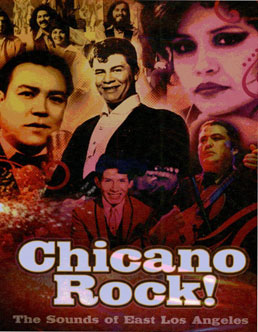 Chicano Rock: The Sounds of East Los Angeles (2008) The post-World War II East LA barrio had an outsized influence on roots rock. Los Lobos didn’t come out of nowhere, and the local fans’ taste for sweet soul music united them with South Central. The elegance of the 1950s scene is honored in interviews with survivors of the area’s first-tier band, Thee Midnighters, a tight group with a hot brass section that had a jumbo hit with their version of “Land of a Thousand Dances” as well as an instrumental heralding the main street of the East Side, “Whittier Blvd.” Casey Kasem himself, interviewed here, says that they were the best band he ever hired. What started with dance music ended with ballads of Chicano power. Edward James Olmos narrates. (RvB)
Chicano Rock: The Sounds of East Los Angeles (2008) The post-World War II East LA barrio had an outsized influence on roots rock. Los Lobos didn’t come out of nowhere, and the local fans’ taste for sweet soul music united them with South Central. The elegance of the 1950s scene is honored in interviews with survivors of the area’s first-tier band, Thee Midnighters, a tight group with a hot brass section that had a jumbo hit with their version of “Land of a Thousand Dances” as well as an instrumental heralding the main street of the East Side, “Whittier Blvd.” Casey Kasem himself, interviewed here, says that they were the best band he ever hired. What started with dance music ended with ballads of Chicano power. Edward James Olmos narrates. (RvB)
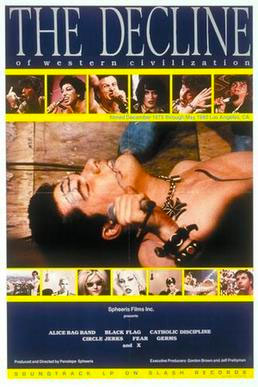 The Decline of Western Civilization (1981) Penelope Spheeris’ irresistible documentary on the roots of the rawest punk sound in Los Angeles is something of a classic. Spheeris deserves credit not just for being there first with the most, but for also being a cool enough director to calm ambient suspicions of selling out to Hollywood. It has the best existent footage of X (seen at home inking some self-inflicted tattoos). The Germs’ ill-fated singer Darby Crash shows his sensitive side during a breakfast of toast and green mint jelly; he’s counterpointed nicely by Lee Harvey Oswald look-alike Lee Ving’s gargantuan stage rudeness, introducing a single-entendre song about beef baloney. Here also is Alice Bag, lately an articulate memoirist of the time; and annoying French journalist Claude Bessy of Slash magazine. Spheeris returned to the L.A. club scene in 1988 to capture teased hair and headbanging in The Decline of Western Civilization Part II: The Metal Years. Most recently she’s narrated the true crime podcast Peter & The Acid King, about the unsolved murder of L.A. punk musician/scenester Peter Ivers. (RvB)
The Decline of Western Civilization (1981) Penelope Spheeris’ irresistible documentary on the roots of the rawest punk sound in Los Angeles is something of a classic. Spheeris deserves credit not just for being there first with the most, but for also being a cool enough director to calm ambient suspicions of selling out to Hollywood. It has the best existent footage of X (seen at home inking some self-inflicted tattoos). The Germs’ ill-fated singer Darby Crash shows his sensitive side during a breakfast of toast and green mint jelly; he’s counterpointed nicely by Lee Harvey Oswald look-alike Lee Ving’s gargantuan stage rudeness, introducing a single-entendre song about beef baloney. Here also is Alice Bag, lately an articulate memoirist of the time; and annoying French journalist Claude Bessy of Slash magazine. Spheeris returned to the L.A. club scene in 1988 to capture teased hair and headbanging in The Decline of Western Civilization Part II: The Metal Years. Most recently she’s narrated the true crime podcast Peter & The Acid King, about the unsolved murder of L.A. punk musician/scenester Peter Ivers. (RvB)
Echo in the Canyon (2018) For those who can’t get enough of the Laurel Canyon scene, this film by Andrew Slater offers more of the same. Jakob Dylan (yes, Bob’s son) interviews Jackson Browne, Tom Petty, Roger McGuinn, Michelle Phillips, Eric Clapton, Ringo Starr, and some others—but there are some notable oversights: no Joni Mitchell, no Jim Morrison, no members of Love (the late, great Arthur Lee deserves far more attention than he has received). As for the music itself, some tunes are revived by a group of younger artists—including Fiona Apple, Norah Jones, Beck and Cat Power—in a tribute concert.
Ghostride the Whip: The Hyphy Movement (2008) Executive producer Peter Spirer and director DJ Vlad explore the Bay Area’s hyphy scene, focusing on Vallejo rapper Mac Dre (whose 2004 murder is still unsolved) and other hip hop artists, including E-40, Keak Da Sneak, and Mistah FAB. Bay Area elder statesmen MC Hammer and Too $hort are interviewed, and there’s also footage of the titular activity: walking, running or dancing next to a moving car with no driver—a risky practice that epitomizes this high-energy underground music scene.
It’s Gonna Blow!!!: San Diego's Music Underground 1986-1996 (2014) The Casbah. Ché Café. Lou’s Records. Director Bill Perrine’s documentary excavates San Diego’s punk past and interviews a couple dozen musicians from the era. There’s DIY footage aplenty, as raw and gritty as the scene itself. San Diego was supposed to be the next Seattle, muses Tim Blackenship. “But evidently it didn’t work out that way.” Fans were notoriously rough, with one piece of archival footage showing Orange County band the Vandals attacked by skinheads in the audience. The interviewees share their admiration for Rocket From the Crypt and Pitchfork as the hot acts back in the day, but it was Blink-182, which hailed from suburban Poway (motto: “the city in the country”), that found fame.
Jazz on the West Coast: The Lighthouse (2005) West Coast jazz, based in Los Angeles and San Francisco, got a home closer to the beach in the 1950s when bar owner John Levine teamed up with jazz musician Howard Rumsey (formerly with Stan Kenton’s band) to turn Levine’s flailing Hermosa Beach dive into a magnet for big-names players. Rumsey’s Lighthouse All-Stars—featuring drummer Max Roach, composer-trumpeter Shorty Rogers, and saxophonist Jimmy Giuffre—played bebop six nights a week, and stars like Miles Davis, Lee Morgan, Art Blakey and Wes Montgomery also came out to shine.
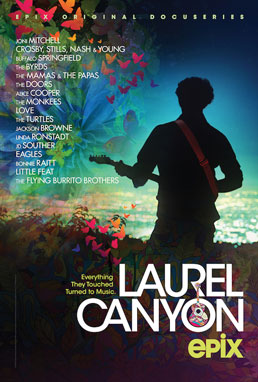 Laurel Canyon: A Place in Time (2020) There’s not a dearth of documentaries on the twin focal points of California’s summer of love: Haight-Ashbury and Laurel Canyon. But sometimes it helps to have an outsider take a second look. Alison Ellwood, the Aussie director of Laurel Canyon, a two-part, 3½-hour limited series that debuted on Epix, brings a freshness to the subject, with archival footage and contemporary interviews about “this truly magical bubble that gurgled up,” as she told the Los Angeles Times. (Ellwood had already turned her lens on other famed Laurel Canyon residents in the two-part documentary History of the Eagles, which came out in 2013.) Surviving rockers participate as narrators, including Graham Nash, David Crosby, Linda Ronstadt, Alice Cooper, Michelle Phillips, the Monkees’ Mickey Dolenz and Mike Nesmith, and the Doors’ Robbie Krieger. Through archival footage, we hear from deceased stars such as Love’s Arthur Lee, Frank Zappa, Cass Elliot and Jim Morrison. And photographers Henry Diltz and Nurit Wilde offer up images as well as indelible recollections.
Laurel Canyon: A Place in Time (2020) There’s not a dearth of documentaries on the twin focal points of California’s summer of love: Haight-Ashbury and Laurel Canyon. But sometimes it helps to have an outsider take a second look. Alison Ellwood, the Aussie director of Laurel Canyon, a two-part, 3½-hour limited series that debuted on Epix, brings a freshness to the subject, with archival footage and contemporary interviews about “this truly magical bubble that gurgled up,” as she told the Los Angeles Times. (Ellwood had already turned her lens on other famed Laurel Canyon residents in the two-part documentary History of the Eagles, which came out in 2013.) Surviving rockers participate as narrators, including Graham Nash, David Crosby, Linda Ronstadt, Alice Cooper, Michelle Phillips, the Monkees’ Mickey Dolenz and Mike Nesmith, and the Doors’ Robbie Krieger. Through archival footage, we hear from deceased stars such as Love’s Arthur Lee, Frank Zappa, Cass Elliot and Jim Morrison. And photographers Henry Diltz and Nurit Wilde offer up images as well as indelible recollections.
Lo Sound Desert (2015) A scene doesn’t have to be huge to make noise, and it doesn’t need to be in a major metropolis. Director Jörg Steinert turns the cameras on musicians from California’s desert cities—most notably the Queens of the Stone Age and Eagles of Death Metal. Artsy footage of the terrain and the musical bacchanals it inspires adds to the appeal. Notes Mario “Boomer” Lalli, of Yawning Man and Fatso Jetson, “You can go out in the desert and blow shit up, you can fuckin’ shoot guns, ride motorcycles—and you can play music.”
Los Punks: We Are All We Have (2016) Punk rock began and has always been a poor person’s medium, a DIY community builder, a method of protest. Documentary maker Angela Boatwright’s focus is on overlooked punks of South Central and East LA. She interviewed members from Corrupted Youth, Psyk Ward, and the since-disbanded Rhythmic Asylum (whose lead singer Gary Alvarez, a first-generation American, became a law student). Also speaking for themselves are young promoters who are making all-ages shows happen in a series of backyards. (RvB)
Murder in the Front Row: The San Francisco Bay Thrash Metal Story (2019) The four horsemen of thrash metal ride again, as members of Metallica, Anthrax, Slayer and Megadeth testify about the early 1980s, when alienated East Bay lads found an outlet for suburban angst on stage. “The volume, the craziness was epic,” says one interviewee; another adds, “We called it the land of misfit toys.” Also interviewed are bandmates from Testament, Exodus, Possessed, Metal Allegiance, Death Angel and Vio-lence.
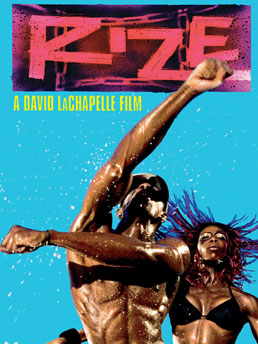 Rize (2005) Stylish photographer David LaChapelle directs here, turning the cameras on practitioners of clowning and krumping—alternative hip hop dance styles that evolved in opposition to the violence of life on L.A.’s mean streets. Rize’s stars include Tommy the Clown (Tom Johnson), creator of the Clown Academy, who says that as a young man he was into drugs and gangs. “Living like that,” he says, “you either wind up shot dead or in jail. I was lucky. I wound up in jail.” Krumping, on the other hand, was invented by Lil C, Tight Eyez and Dragon, who left Tommy’s academy to forge their own style.
Rize (2005) Stylish photographer David LaChapelle directs here, turning the cameras on practitioners of clowning and krumping—alternative hip hop dance styles that evolved in opposition to the violence of life on L.A.’s mean streets. Rize’s stars include Tommy the Clown (Tom Johnson), creator of the Clown Academy, who says that as a young man he was into drugs and gangs. “Living like that,” he says, “you either wind up shot dead or in jail. I was lucky. I wound up in jail.” Krumping, on the other hand, was invented by Lil C, Tight Eyez and Dragon, who left Tommy’s academy to forge their own style.
San Francisco Sounds: A Place in Time (2023) Co-directors Alison Ellwood and Anoosh Tertzakian dig into one decade, one place—1965 to 1975 in San Francisco—and hit a rich vein of unfamiliar footage of some very familiar faces, including Janis Joplin, the Grateful Dead, Jefferson Airplane, Sly and the Family Stone, the Great Society, the Charlatans, Steve Miller, Carlos Santana, Moby Grape, and Country Joe & The Fish. In addition, viewers get the benefit of commentary by contemporary observers, including disc jockey Dusty Street, poster artist Victor Moscoso, light show artist Bill Ham, and Rolling Stone writer Ben Fong-Torres. It’s a two-part series, with the second episode veering into the darker side of the scene: addiction, fatal overdoses, and “selling out” to record labels.
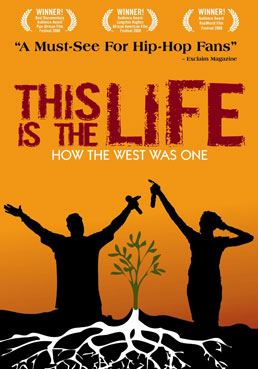 This Is the Life (2008) Critically acclaimed filmmaker Ava DuVernay (Selma) made her feature-length directorial debut with this documentary about the underground hip hop scene that grew in gangsta rap’s shadow. With performer interviews, VHS footage, and audio clips, she recreates the sense of community at the Good Life Cafe, a South Central L.A. health food cafe that attracted underground rappers during the 1990s. DuVernay provides an insider’s view, having performed at the cafe as part of the rap duo Figures of Speech.
This Is the Life (2008) Critically acclaimed filmmaker Ava DuVernay (Selma) made her feature-length directorial debut with this documentary about the underground hip hop scene that grew in gangsta rap’s shadow. With performer interviews, VHS footage, and audio clips, she recreates the sense of community at the Good Life Cafe, a South Central L.A. health food cafe that attracted underground rappers during the 1990s. DuVernay provides an insider’s view, having performed at the cafe as part of the rap duo Figures of Speech.
Turn It Around: The Story of East Bay Punk (2017) Twenty years and maybe a thousand bands are covered, all drawn by a lodestar—the booze-free precinct of the still-operating 924 Gilman Street Berkeley performance space. Iggy Pop narrates this exhaustive account of the DIY scene, which produced some big noises. El Sobrante’s Green Day are the ones who made it to fame, and they pay it back by producing this lively, grimy chronicle about their roots. There has probably never been a documentary on punk that had so many women’s voices in it—personnel from all-female bands such as Spitboy and the Yeastie Girls, and journalist and Mordam Records exec Ruth Schwartz. (RvB)
Uprising: Hip Hop & The LA Riots (2012) Narrated by Snoop Dogg, this short documentary examines the 1992 Los Angeles urban insurrection that left 63 dead and a billion dollars in damage behind it. Mark Ford’s hour-long documentary concerns the music of the streets. Those who listened could have anticipated the clash between a paramilitary LAPD and a ringed-in South Central population that wrongly thought they’d get justice after the world saw the brutal police beating of Rodney King, captured on VHS tape. King is interviewed, showing the camera where he was stomped by four cops. Yet Ford chose well in making Henry Watson the face of this riot. Watson was arrested in the assault on white truck driver Reginald Denny. Humane but indomitable, Watson walks a line between regret and righteous fury. The music that anticipated the riot: Ice T and Body Count’s shredder “Cop Killa” (just described this month as “the most dangerous song of the 1990s” in Rolling Stone); N.W.A’s “Fuck Tha Police” (released before the fires started); and lastly Dr. Dre’s debut, The Chronic, a kind of weed-loaded peace pipe smoked by warring gangs. (RvB)
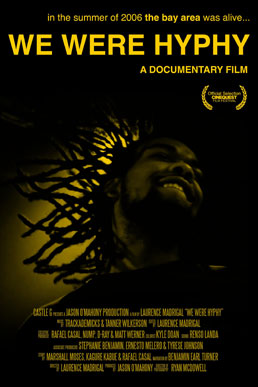 We Were Hyphy (2022) An indispensable guide to the hyphy movement, this documentary by Laurence Madrigal celebrates all aspects of the San Francisco Bay Area cultural tidal wave: not only the music but also dance moves, slang and fashion. Packed with interviews, We Were Hyphy debuted at Cinejoy (San Jose’s online film festival) and aired on PBS and can be viewed online at PBS.org.
We Were Hyphy (2022) An indispensable guide to the hyphy movement, this documentary by Laurence Madrigal celebrates all aspects of the San Francisco Bay Area cultural tidal wave: not only the music but also dance moves, slang and fashion. Packed with interviews, We Were Hyphy debuted at Cinejoy (San Jose’s online film festival) and aired on PBS and can be viewed online at PBS.org.
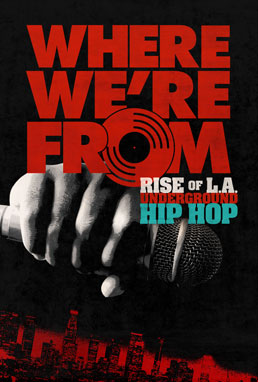 Where We’re From: Rise of L.A. Underground Hip Hop (2021) Elements, an underground club active in Los Angeles from 1998 to 2002, is the focal point of this movie (aka Where We’re From: The Elements Documentary), which is also an essential history lesson for those who think L.A. is all about gangsta rap and don’t grasp the multitudes contained within West Coast hip hop. (As J-Ro of Tha Alkaholiks says, “you have Ice Cube and you have Del tha Funky Homosapien, and they’re fucking cousins.”) Club founders DJ Bonds and DJ Breeze, who also directed, recount their misadventures as promoters. While they didn’t get rich, as Bonds says, “At the end of the day, what we did was dope.”
Where We’re From: Rise of L.A. Underground Hip Hop (2021) Elements, an underground club active in Los Angeles from 1998 to 2002, is the focal point of this movie (aka Where We’re From: The Elements Documentary), which is also an essential history lesson for those who think L.A. is all about gangsta rap and don’t grasp the multitudes contained within West Coast hip hop. (As J-Ro of Tha Alkaholiks says, “you have Ice Cube and you have Del tha Funky Homosapien, and they’re fucking cousins.”) Club founders DJ Bonds and DJ Breeze, who also directed, recount their misadventures as promoters. While they didn’t get rich, as Bonds says, “At the end of the day, what we did was dope.”
Some were born in the state; others adopted it. Either way, these musical acts made history here.
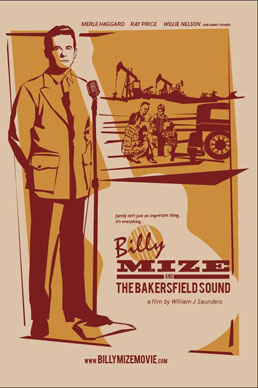 Billy Mize and the Bakersfield Sound (2014) Director William J. Saunders honors his grandfather. Big in the local scene but never nationally known, silenced by a stroke at age 59, Billy Mize was an influence on talents that went all the way. It’s said here that Elvis learned to dress from Mize; true or not, Mize was a TV star in the Bakersfield area with fans from Merle Haggard to Dave Alvin. What’s particularly valuable is an anatomy of the Bakersfield contribution to country music, images of that oilpatch wrangling that made the Kern County town a place that could hold its own with other hotspots of country such as Fort Worth and Nashville. Even the Beatles covered Bakersfield’s own Buck Owens. (RvB)
Billy Mize and the Bakersfield Sound (2014) Director William J. Saunders honors his grandfather. Big in the local scene but never nationally known, silenced by a stroke at age 59, Billy Mize was an influence on talents that went all the way. It’s said here that Elvis learned to dress from Mize; true or not, Mize was a TV star in the Bakersfield area with fans from Merle Haggard to Dave Alvin. What’s particularly valuable is an anatomy of the Bakersfield contribution to country music, images of that oilpatch wrangling that made the Kern County town a place that could hold its own with other hotspots of country such as Fort Worth and Nashville. Even the Beatles covered Bakersfield’s own Buck Owens. (RvB)
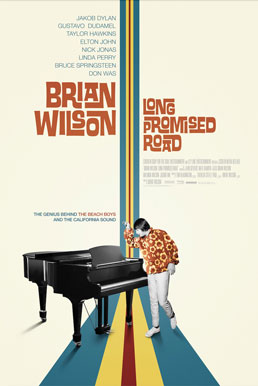 Brian Wilson: Long Promised Road (2021) In addition to all the documentary footage expended on the Beach Boys, there have been two documentaries spotlighting the leader of the quintessential Southern California band. Brian Wilson’s musical genius was equaled by his mental illness, which makes him a compelling subject. Brian Wilson: Long Promised Road takes a lighter approach, with interviews conducted by a friend, journalist Jason Fine, following the musician around as he visits former homes and hangouts. Prior to this came Don Was’ 1995 documentary, Brian Wilson: I Just Wasn’t Made for These Times, which depicts a more garrulous Wilson.
Brian Wilson: Long Promised Road (2021) In addition to all the documentary footage expended on the Beach Boys, there have been two documentaries spotlighting the leader of the quintessential Southern California band. Brian Wilson’s musical genius was equaled by his mental illness, which makes him a compelling subject. Brian Wilson: Long Promised Road takes a lighter approach, with interviews conducted by a friend, journalist Jason Fine, following the musician around as he visits former homes and hangouts. Prior to this came Don Was’ 1995 documentary, Brian Wilson: I Just Wasn’t Made for These Times, which depicts a more garrulous Wilson.
David Crosby: Remember My Name (2019) Released around the same time as a spate of documentaries about the Laurel Canyon scene, this singularly focused cinematic portrait examines the misadventures of David Crosby, one-fourth of the famed supergroup Crosby, Stills Nash & Young—the poster child for 1960s rock excess. As the trailer begins, he’s asked, “Do you ever wonder why you are still alive?” He answers, “No idea, man.” Director A.J. Eaton and producer Cameron Crowe continue with other challenging questions, and Crosby—who died in January 2023—does his best to give brutally honest answers.
D Tour (2008) This soulful doc follows Pat Spurgeon, drummer for the Oakland indie rock band Rogue Wave, as he deals with kidney disease during a series of concert tours, self-administering dialysis and awaiting a donor. The film is framed by a benefit concert featuring performances by Bay Area musicians who were collectively having a moment, including Ben Gibbard (Death Cab for Cutie), John Vanderslice, Nada Surf, and Rogue Wave themselves. According to the San Francisco Film Society, “D Tour turns out to be less rock band/rock star road-show than a grimy tale of working class musicians and the healthcare system, as Spurgeon drags his dialysis kit on a glamour-less cross-country journey from show to show and couch to couch. Along the way, the narrative itself almost gets subverted as the story takes some unexpected and heartbreaking turns. A movie that starts as one man’s story of survival while chasing a dream ends up being just as much about community, sacrifice, and the complicated emotions around organ donation.”
Everyday Sunshine: The Story of Fishbone (2010) Fishbone could play that “stringy-haired white boy music” (such was a putdown Fishbone’s members heard). Their tune “Subliminal Fascism” was pure political punk rock. And like the Minutemen, another ornament of the post-punk scene, it didn’t matter that they were much better musicians than a lot of the bands for whom they opened. If Fishbone had been British, they would have had a better chance: there was such a thing as “two-tone” music in England. But they were in L.A., in the volatile years before the ’92 riots blew everything up. Interviewer David Kahne of Columbia Records defines Fishbone’s demographic woes: too white for a black audience and too black for a white audience. Kahne considers Columbia’s ultimate inability to make the band huge as the single biggest failure of his career. Primus’ Les Claypool opines that there never was a studio recording that brought out Fishbone as well as when they played live. While the band’s members made loco decisions–obsessions with theremins, brushes with a Christian cult that forced converts to shave their heads—it’s a story of failure through artistic decisions and marketplace demands…on top of the wear and tear of what narrator Laurence Fishburne describes as “25 goddamn years on the road.” (RvB)
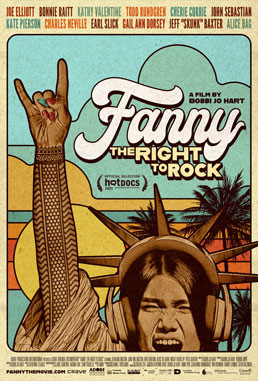 Fanny: The Right to Rock (2021) One of the first all-female rock groups to sign a record deal, Fanny started off in Sacramento but moved to Los Angeles, where the band landed a contract with Reprise Records after being discovered at the Troubadour. The quintet—which included Philippines-born sisters June and Jean Millington, who grew up in the California capital—released five albums before disbanding in 1975. Bobbi Jo Hart’s documentary revels in the joyful energy of these women, now in their 60s, as the Millingtons reunite with Brie Darling and Alice de Burh—with appearances by members of the Go-Go’s, the Runaways and the Bangles—to record a new album. (As a companion piece to the movie, don’t miss this in-depth New York Times feature article.)
Fanny: The Right to Rock (2021) One of the first all-female rock groups to sign a record deal, Fanny started off in Sacramento but moved to Los Angeles, where the band landed a contract with Reprise Records after being discovered at the Troubadour. The quintet—which included Philippines-born sisters June and Jean Millington, who grew up in the California capital—released five albums before disbanding in 1975. Bobbi Jo Hart’s documentary revels in the joyful energy of these women, now in their 60s, as the Millingtons reunite with Brie Darling and Alice de Burh—with appearances by members of the Go-Go’s, the Runaways and the Bangles—to record a new album. (As a companion piece to the movie, don’t miss this in-depth New York Times feature article.)
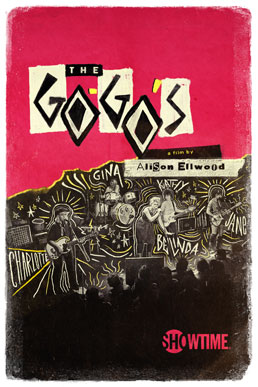 The Go-Go’s (2020) In addition to having native Californians in the lineup—lead singer Belinda Carlisle and songwriter Charlotte Caffey—the Go-Go’s became part of California’s music history when they emerged from the male-dominated Los Angeles punk scene in 1978 as an all-female band doing their own material, including the irrepressible “We Got the Beat.” There’s a wealth of archival footage, but it’s the interviews that make this a must for fans. In line with the title of Carlisle’s autobiography, it’s “Lips Unsealed” all the way around.
The Go-Go’s (2020) In addition to having native Californians in the lineup—lead singer Belinda Carlisle and songwriter Charlotte Caffey—the Go-Go’s became part of California’s music history when they emerged from the male-dominated Los Angeles punk scene in 1978 as an all-female band doing their own material, including the irrepressible “We Got the Beat.” There’s a wealth of archival footage, but it’s the interviews that make this a must for fans. In line with the title of Carlisle’s autobiography, it’s “Lips Unsealed” all the way around.
Joan Baez: I Am a Noise (2023) This well-traveled folk icon may be a citizen of the world, but California has a legitimate claim on her as well. Joan Baez graduated from Palo Alto High School and has lived for years in bucolic Woodside, on the San Francisco Peninsula. A mountain of footage has captured Baez in concert and in interviews since 1958, but this 2023 film is something completely different. Diving deep into Baez’s archives to examine family photos and videos, the artist’s drawings and letters, and audiotaped therapy sessions, I Am a Noise paints a psychological portrait of a woman who devoted her life to the pursuit of social justice, peace and nonviolence but is plagued by personal demons.
Karen Carpenter: Starving for Perfection (2023) Karen and Richard Carpenter had a nationwide hit with “We’ve Only Just Begun” originally written as a jingle for a Bank of America commercial; better than that was their cover of Leon Russell’s poignant “Superstar.” This is the real story of how their relentlessly chipper music disguised authentic pain, particularly Karen’s fatal struggle with anorexia, and as of the end of 2023 it is still on the festival circuit and not yet available via streaming. Todd Haynes (May December) told Karen Carpenter story first in 1987 through what was, in a sense, the first Barbie movie. He used a series of dolls and unauthorized music to semi-animate Superstar: The Karen Carpenter Story, a short—sometimes jesting, sometimes dead earnest—about the rise and fall of the Downey-based brother and sister act. (RvB)
Linda Ronstadt: The Sound of My Voice (2019) Perhaps it’s cheating to include this documentary about Arizona-born Linda Ronstadt, who didn’t arrive on the California scene until she was 18. But it’s hard to imagine L.A. in the 1970s without this versatile chanteuse’s voice ringing through the Hollywood Hills. Seasoned documentary filmmakers Rob Epstein and Jeffrey Friedman follow Ronstadt’s self-propelled journey from folk singer to arena rock star, and her quest to embrace all vocal genres.
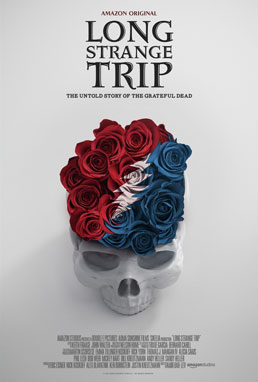 Long Strange Trip (2017) This near-four-hour opus produced by Martin Scorsese, directed by Amir Bar-Lev, and split into six chapters, captures the 30-year history of the Grateful Dead—the band that kept (and keeps) the spirit of the San Francisco sound alive and on tour. There have been other Dead docs, but as the site Vulture asserts, “the new film trumps its predecessors in both method and scope. In assuming the loose expanse of the Dead’s live shows as its structure, it barrels along just as stoned and free as its subjects.”
Long Strange Trip (2017) This near-four-hour opus produced by Martin Scorsese, directed by Amir Bar-Lev, and split into six chapters, captures the 30-year history of the Grateful Dead—the band that kept (and keeps) the spirit of the San Francisco sound alive and on tour. There have been other Dead docs, but as the site Vulture asserts, “the new film trumps its predecessors in both method and scope. In assuming the loose expanse of the Dead’s live shows as its structure, it barrels along just as stoned and free as its subjects.”
Metallica: Some Kind of Monster (2004) Rockumentaries exist in part so that we can watch rock stars make asses of themselves. This vivid documentary charts three excruciating years in Metallica’s neurotic anguish. The band—the most successful in heavy-metal history—can’t choose between shelving their newest album, going on tour, or just basically pulling the plug and slicing the pie. Surprisingly, though, what happens to these musicians turns out to be quite moving. One appreciates the inner calm that has kept guitarist Kirk Hammett out of the squabbling between Lars Ulrich and James Hetfield. Directors Joe Berlinger and Bruce Sinofsky capture something beyond mockery. And it’s uplifting when the band finally snaps into place, after the young bass player Robert Trujillo signs on. But would the members of Metallica have survived the shock of accepting this hot new talent without the patient, sometimes humiliating work they did on their psyches? This movie serves as a ringing endorsement for the much-mocked Northern California way of dealing with crisis: through endless therapy, discussion and getting in touch with the emotions. (RvB)
Screamers (2006) A Southern California metal band inspired by the likes of Slayer, Mr. Bungle, and the Dead Kennedys, System of a Down is also rooted in Glendale’s Armenian-American community—one of the largest in the United States. That background led to this project, which is part concert movie and part historical documentary about the Armenian genocide and other tragedies of mass murder that have followed. The movie includes an interview with lead singer Serj Tankian’s grandfather, one the the few remaining eyewitnesses to the atrocities.
The Sparks Brothers (2021) Director Edgar Wright (Shaun of the Dead) did this comedic rockumentary about the improbable rise and persistence of Ron and Russel Mael’s 50-year-long act. Sparks’ matchlessly quirky albums of the 1970s were often seemingly gossamer novelty tunes. But turned out to have lasting tensile strength—these UCLA film students who did the cinematic “This Town Ain’t Big Enough for the Both of Us” influenced countless musicians who came after them. Vaguely understood to be suave Londoners, the two were actually from Santa Monica (Russell was a quarterback at SaMoHi). If a director’s passion could sway an audience, Sparks would be as big as ABBA. (RvB)
Some of the most beloved concert films around were shot in California. Here are a few of our favorites.
Celebration at Big Sur (1971) A hunt for this documentary by Baird Bryant and Johanna Demetrakas led to YouTube, where footage of Joan Baez, Joni Mitchell, gospel singer Dorothy Combs Morrison, and CSNY is available in pieces along with cinema verite encounters with police and concert-goers. Or, boomers who own DVD players might track down a copy on TheVideoBeat.com.
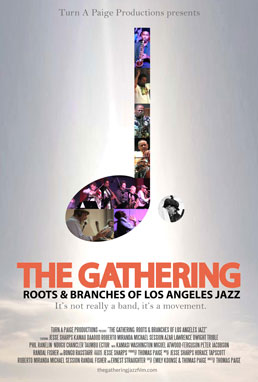 The Gathering: Roots and Branches of Los Angeles Jazz (2019) In both the past and present, Leimert Park Village has been a magnet for African-American art, music, and culture in Los Angeles. The Gathering explores a multi-generational music project started in 2005 by Jesse Sharps, a composer and an early bandleader of Horace Tapscott’s Pan Afrikan Peoples Arkestra. The film mixes live performances, recording-session footage, and interviews with local musicians, including Kamau Daáood, Phil Ranelin, and Kamasi Washington. Check the movie’s website for future screenings, and find a trailer here.
The Gathering: Roots and Branches of Los Angeles Jazz (2019) In both the past and present, Leimert Park Village has been a magnet for African-American art, music, and culture in Los Angeles. The Gathering explores a multi-generational music project started in 2005 by Jesse Sharps, a composer and an early bandleader of Horace Tapscott’s Pan Afrikan Peoples Arkestra. The film mixes live performances, recording-session footage, and interviews with local musicians, including Kamau Daáood, Phil Ranelin, and Kamasi Washington. Check the movie’s website for future screenings, and find a trailer here.
Gimme Shelter (1970) Just two years after the Monterey Pop Festival, things had changed—and acclaimed filmmakers Albert and David Maysles were there to document a far different live music event. Their footage of the denouement from the Rolling Stones’ disastrous free concert at Altamont has become a staple in virtually every compendium of the turbulent ’60s ever made.
The Last Waltz (1978) As with Stop Making Sense (below), the inclusion of Martin Scorsese’s documentary on The Band’s 1976 farewell concert is part of California music history because of its setting: Winterland Ballroom in San Francisco, where Bill Graham produced concerts from 1966 to the late 1970s. Joining the Canadian-American band for their final concert were such luminaries as Bob Dylan, Neil Diamond, Joni Mitchell, Muddy Waters and many others.
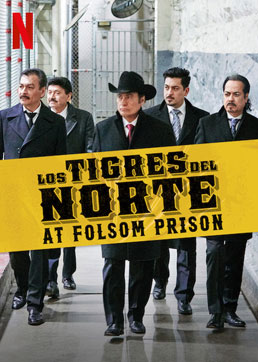 Los Tigres Del Norte at Folsom Prison (2019) Born in the Mexican state of Sinaloa, the members of Los Tigres del Norte headed to San Jose in the late 1960s, while still in their teens. Around that time, Johnny Cash recorded an iconic album at Folsom Prison. Fifty years later—after earning seven Grammy Awards, six Latin Grammys, and a star on the Hollywood Walk of Fame—the five members of Los Tigres played at the California prison, in tribute to the man in black. The Netflix documentary features concert footage and interviews with male and female inmates, who share the circumstances that put them behind Folsom’s walls. It leaves one feeling (to quote another songwriter) “there but for fortune go you or I.”
Los Tigres Del Norte at Folsom Prison (2019) Born in the Mexican state of Sinaloa, the members of Los Tigres del Norte headed to San Jose in the late 1960s, while still in their teens. Around that time, Johnny Cash recorded an iconic album at Folsom Prison. Fifty years later—after earning seven Grammy Awards, six Latin Grammys, and a star on the Hollywood Walk of Fame—the five members of Los Tigres played at the California prison, in tribute to the man in black. The Netflix documentary features concert footage and interviews with male and female inmates, who share the circumstances that put them behind Folsom’s walls. It leaves one feeling (to quote another songwriter) “there but for fortune go you or I.”
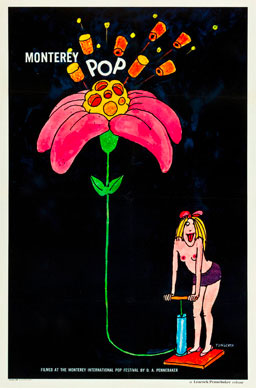 Monterey Pop (1968) The coastal fog of the Monterey Pop Festival in 1967, as filmed by D.A. Pennebaker (Don’t Look Back) and collaborators Richard Leacock and Albert Maysles (Gimme Shelter). In a recently filmed preamble, the nonagenarian Pennebaker describes the secret of the film’s success: it was made as a charitable nonprofit by producer Lou Adler, the musicians aboard all worked for scale as equals, and then-new sound cameras meant the event could be caught with surprising intimacy and a democratic lens. Jimi Hendrix is ludicrously handsome in a yellow pirate shirt and a Central Asian vest as he kneels to immolate his guitar with a goodbye kiss to the soon-to-be-martyred instrument, in one of the most powerful rock-concert moments ever committed to film.
Monterey Pop (1968) The coastal fog of the Monterey Pop Festival in 1967, as filmed by D.A. Pennebaker (Don’t Look Back) and collaborators Richard Leacock and Albert Maysles (Gimme Shelter). In a recently filmed preamble, the nonagenarian Pennebaker describes the secret of the film’s success: it was made as a charitable nonprofit by producer Lou Adler, the musicians aboard all worked for scale as equals, and then-new sound cameras meant the event could be caught with surprising intimacy and a democratic lens. Jimi Hendrix is ludicrously handsome in a yellow pirate shirt and a Central Asian vest as he kneels to immolate his guitar with a goodbye kiss to the soon-to-be-martyred instrument, in one of the most powerful rock-concert moments ever committed to film.
The mortality rate here is chilling: Otis Redding, Hendrix, Janis Joplin, Keith Moon, Cass Elliot and Brian Jones all died young. Adler’s main attraction includes the overplayed song about California, but the Mamas and the Papas are far sweeter on “Got a Feeling,” a dirge for dying love, iced with spine-tingling electric harpsichord. “The joke’s on you” is the key line, and it certainly was: Every one of the bliss-whipped, fog-caressed crowd was about to get a horrifying lesson in realpolitik in the coming year of 1968. (RvB)
Stop Making Sense (1984) What’s the California connection? The recently re-released Jonathan Demme film—considered by many to be one of the best concert films ever—was filmed entirely at Hollywood’s Pantages Theater, a stunning Art Deco theater built in 1930.
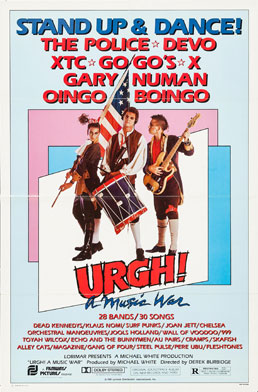 Urgh! A Music War (1981) Producer Miles Copeland staged a series of concerts in a half-dozen American and European cities. It contains a cavalcade of the highest and the best of the punk rock/new wave era, and it’s quite an emotional film for its survivors to watch. At last the cameras were there at the right place in the right time to catch the bands: the Bay Area’s Dead Kennedys’ snarling response to CIA skullduggery in “Bleed for Me”; L.A.’s own X does “Beyond and Back”; Pere Ubu’s David Thomas is filmed in San Francisco. The pure eclecticism of the early 1980s scene is on display throughout, from sunshiny pop by Oingo Boingo, the Go-Go’s, and the Surf Punks to serious-as-cancer analyses of sexual and racial politics by the likes of The Au-Pairs and the Gang of Four. And shot at the Santa Monica Civic, the Cramps’ mind-roasting cover of Johnny Burnette’s “Tear it Up” remains on the short list of the greatest things I ever saw. Mascara-eyed scarecrow Lux Interior huffs the mike as Ivy Rorschach seems to be wondering where she left her cat o’ nine tails. (RvB)
Urgh! A Music War (1981) Producer Miles Copeland staged a series of concerts in a half-dozen American and European cities. It contains a cavalcade of the highest and the best of the punk rock/new wave era, and it’s quite an emotional film for its survivors to watch. At last the cameras were there at the right place in the right time to catch the bands: the Bay Area’s Dead Kennedys’ snarling response to CIA skullduggery in “Bleed for Me”; L.A.’s own X does “Beyond and Back”; Pere Ubu’s David Thomas is filmed in San Francisco. The pure eclecticism of the early 1980s scene is on display throughout, from sunshiny pop by Oingo Boingo, the Go-Go’s, and the Surf Punks to serious-as-cancer analyses of sexual and racial politics by the likes of The Au-Pairs and the Gang of Four. And shot at the Santa Monica Civic, the Cramps’ mind-roasting cover of Johnny Burnette’s “Tear it Up” remains on the short list of the greatest things I ever saw. Mascara-eyed scarecrow Lux Interior huffs the mike as Ivy Rorschach seems to be wondering where she left her cat o’ nine tails. (RvB)
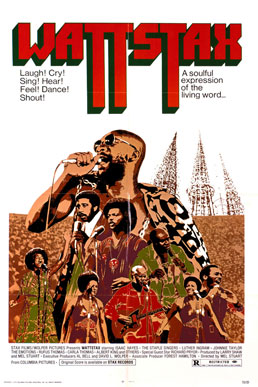 Wattstax (1973) Rock critic Gina Arnold’s study of rock concerts, Half a Million Strong: Crowds and Power from Woodstock to Coachella, gives this concert movie—filmed at the Los Angeles Coliseum, some distance from Watts—primacy over the far better known Woodstock. Produced by the Stax record label to commemorate the seventh anniversary of the Watts Riots, the lineup is irreplaceable: bluesman Albert King, the man-mountain Isaac Hayes of “Theme from Shaft” fame, the Bar-Kays, the Staple Singers, that Memphis-based auteur of the Funky Chicken Rufus Thomas, and comedy by Richard Pryor. Shot by cinematographer John A. Alonzo (De Palma’s Scarface, Harold and Maude). (RvB)
Wattstax (1973) Rock critic Gina Arnold’s study of rock concerts, Half a Million Strong: Crowds and Power from Woodstock to Coachella, gives this concert movie—filmed at the Los Angeles Coliseum, some distance from Watts—primacy over the far better known Woodstock. Produced by the Stax record label to commemorate the seventh anniversary of the Watts Riots, the lineup is irreplaceable: bluesman Albert King, the man-mountain Isaac Hayes of “Theme from Shaft” fame, the Bar-Kays, the Staple Singers, that Memphis-based auteur of the Funky Chicken Rufus Thomas, and comedy by Richard Pryor. Shot by cinematographer John A. Alonzo (De Palma’s Scarface, Harold and Maude). (RvB)
These docs go behind the scenes to shed light on “the star-making machinery behind the popular song.”
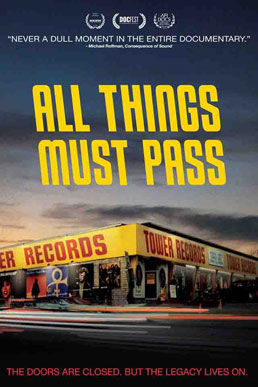 All Things Must Pass (2015) Rather than chronicling a music scene, Colin Hanks instead looks at an era, a Zeitgeist, in this documentary about the rise and fall of Tower Records. Two titles right at the beginning say it in a nutshell: In 1999, Tower Records was a billion dollar company. Five years later, it was bankrupt. Proving himself no nepo baby, Hanks finds the drama, wonder and poignancy in the story of how, starting in 1960, company founder Russ Solomon parlayed one record store in Sacramento into a ubiquitous national brand.
All Things Must Pass (2015) Rather than chronicling a music scene, Colin Hanks instead looks at an era, a Zeitgeist, in this documentary about the rise and fall of Tower Records. Two titles right at the beginning say it in a nutshell: In 1999, Tower Records was a billion dollar company. Five years later, it was bankrupt. Proving himself no nepo baby, Hanks finds the drama, wonder and poignancy in the story of how, starting in 1960, company founder Russ Solomon parlayed one record store in Sacramento into a ubiquitous national brand.
A Fat Wreck (2016) The blissful hippie scene of the 1960s was long gone by the ’80s and ’90s, when the tech boom was battering San Francisco’s less affluent. Slackers found solace in the music released by Fat Wreck Chords, which has prided itself on “ruining punk rock” for the past 25 years. The record label was started in 1990 by NOFX lead singer Michael Burkett (aka Fat Mike) and his then-wife, Erin Burkett. Director Shaun Colon uses puppets to tell some parts of the story, giving the doc an appropriate DIY feel. Colon even raised money for the project through Indiegogo.
Immediate Family (2023) In The Wrecking Crew (see below), director Denny Tedesco focused on the famed session musicians who fueled rock and pop hits in the 1960s. In Immediate Family, debuting Dec. 15, he chronicles the crew that came next: Danny Kortchmar, Russ Kunkel, Steve Postell, Leland Sklar and Waddy Wachtel, who crafted the soundtrack of L.A.’s singer-songwriter era.
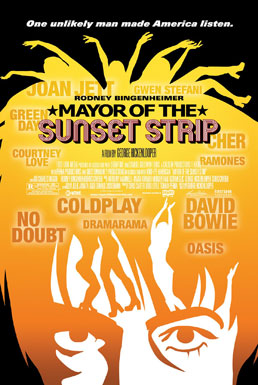 Mayor of the Sunset Strip (2003) Strangely moving documentary about a lifelong fan. Still active on Sirius radio’s Channel 21, the Mountain View-raised Rodney Bingenheimer is described as “The King of Los Angeles Radio”; he DJ’d on Los Angeles’ then most eclectic radio station, KROQ, for a decade, and also emceed the famous Rodney Bingenheimer’s English Disco in Hollywood. Bingenheimer’s knowledge of English bands was more thorough than David Bowie’s—or so Bowie claims here. After being Davy Jones’ double on The Monkees TV show, Rodney began his career as a go-between: as he says, “the bridge between the famous and the not so famous.” Bingenheimer was an early devotee of the church of St. Warhol, accepting the doctrine of salvation through contact with celebrities. In an interview, Cher notes, “Rodney just seemed very gentle. You didn’t have to wonder what his ulterior motives were.” L.A. is so full of ulterior motives that the exterior motive is almost extinct. (RvB)
Mayor of the Sunset Strip (2003) Strangely moving documentary about a lifelong fan. Still active on Sirius radio’s Channel 21, the Mountain View-raised Rodney Bingenheimer is described as “The King of Los Angeles Radio”; he DJ’d on Los Angeles’ then most eclectic radio station, KROQ, for a decade, and also emceed the famous Rodney Bingenheimer’s English Disco in Hollywood. Bingenheimer’s knowledge of English bands was more thorough than David Bowie’s—or so Bowie claims here. After being Davy Jones’ double on The Monkees TV show, Rodney began his career as a go-between: as he says, “the bridge between the famous and the not so famous.” Bingenheimer was an early devotee of the church of St. Warhol, accepting the doctrine of salvation through contact with celebrities. In an interview, Cher notes, “Rodney just seemed very gentle. You didn’t have to wonder what his ulterior motives were.” L.A. is so full of ulterior motives that the exterior motive is almost extinct. (RvB)
Sound City (2013) Drummer Dave Grohl directs this account of the Van Nuys studio that endured from 1969 to 2011; he and his comrades in Nirvana recorded Nevermind there, and when it finally closed Grohl purchased a rare piece of electronics from the studio that was key to the grungy sound. While it’s a documentary in which big names figure, such as Neil Young and Stevie Nicks, it’s also about the workaday side of recording music—a way of life made obsolete by household studios for the rich and Garageband-like apps for the poorer. (RvB)
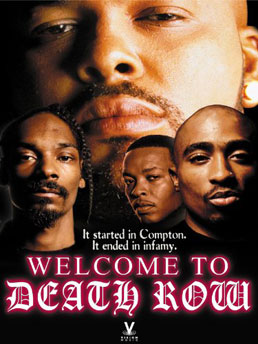 Welcome to Death Row (2001) Founded in 1991 in Los Angeles by Suge Knight, Dick Griffey, the D.O.C. and Dr. Dre, Death Row Records hit hard in its early years with Dre’s The Chronic, Snoop Dogg’s Doggystyle and Tupac Shakur’s All Eyez on Me. But don’t expect to hear the music—this is a behind-the-scenes story. And what a scene it was, filled with criminal charges, lawsuits, incarcerations, and Shakur’s murder. Though Knight is in jail now, some of the label’s artists emerged unscathed. Dre and Interscope Records co-founder Jimmy Iovine teamed up to create Beats headphones (chronicled in the documentary The Defiant Ones); Snoop, pitchman for Skechers and Corona, now owns Death Row.
Welcome to Death Row (2001) Founded in 1991 in Los Angeles by Suge Knight, Dick Griffey, the D.O.C. and Dr. Dre, Death Row Records hit hard in its early years with Dre’s The Chronic, Snoop Dogg’s Doggystyle and Tupac Shakur’s All Eyez on Me. But don’t expect to hear the music—this is a behind-the-scenes story. And what a scene it was, filled with criminal charges, lawsuits, incarcerations, and Shakur’s murder. Though Knight is in jail now, some of the label’s artists emerged unscathed. Dre and Interscope Records co-founder Jimmy Iovine teamed up to create Beats headphones (chronicled in the documentary The Defiant Ones); Snoop, pitchman for Skechers and Corona, now owns Death Row.
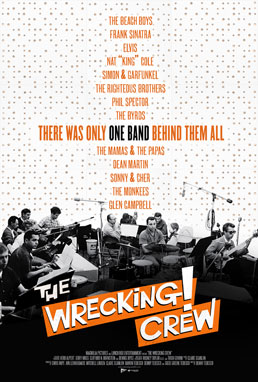 The Wrecking Crew (2008) Love a riff on a Top 40 hit from the 1960s? Odds are decent that a member of the Wrecking Crew—a loose group of Hollywood session musicians—played on the track. Plas Johnson’s sly sax on “The Pink Panther Theme.” Carol Kaye’s bouncing bass on Sonny and Cher’s “The Beat Goes On.” Hal Blaine’s solo drum pulse on Herb Alpert’s “Taste of Honey.” Director Denny Tedesco—son of the late guitarist Tommy Tedesco—hangs out with his dad’s work buddies while they talk about what it was like to crank out an album in a day or work overtime for notorious perfectionists like Beach Boys leader Brian Wilson and Phil “Wall of Sound” Spector. Though overlong, this meticulously documented work gives a complete picture of a specific period in L.A.’s music history, when producers ruled and pop stars set their instruments down and watched as the big-leaguers cranked out the instrumental tracks for their vocals. Then one day it ended. As songwriter Jimmy Webb says, “It was just like a magic bubble. And then the bubble popped.”
The Wrecking Crew (2008) Love a riff on a Top 40 hit from the 1960s? Odds are decent that a member of the Wrecking Crew—a loose group of Hollywood session musicians—played on the track. Plas Johnson’s sly sax on “The Pink Panther Theme.” Carol Kaye’s bouncing bass on Sonny and Cher’s “The Beat Goes On.” Hal Blaine’s solo drum pulse on Herb Alpert’s “Taste of Honey.” Director Denny Tedesco—son of the late guitarist Tommy Tedesco—hangs out with his dad’s work buddies while they talk about what it was like to crank out an album in a day or work overtime for notorious perfectionists like Beach Boys leader Brian Wilson and Phil “Wall of Sound” Spector. Though overlong, this meticulously documented work gives a complete picture of a specific period in L.A.’s music history, when producers ruled and pop stars set their instruments down and watched as the big-leaguers cranked out the instrumental tracks for their vocals. Then one day it ended. As songwriter Jimmy Webb says, “It was just like a magic bubble. And then the bubble popped.”
Article exploring songs, books, movies and other works from art and culture which feature our beautiful state.